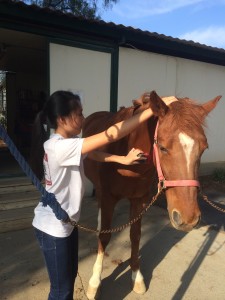Very often we hear the parents of our beginning students lament, “Why does my child spend so much time on the ground stuff? Don’t I pay you to teach them how to ride horses?”
At CRK Training Stable all students must learn to catch, lead, tie, groom, and saddle their school horse. They must also un-tack, groom and put the horse away. In the beginning of their riding careers, students often spend more time working with the horse on the ground than in the saddle. While we understand that this may not seem like what you signed up for, the ground work is a very important step to becoming an equestrian. Here’s why…
At CRK we teach horsemanship. Not just horse riding- Horsemanship. What is horsemanship? The Britannica.com definition is- Horsemanship- The art of riding, handling, and training horses. While riding is certainly part of horsemanship, it is not the only part. Handling and training is also part of the deal.
When do riders start training a horse? The very first time they step into that horse’s personal space. Every interaction a person has with a horse is affecting it’s training. Sometimes for the better. Sometimes not. We want our students to be good horse trainers and that begins on the ground.
Students learn mastery of the horse from the ground up. By entering the horses space, putting on the halter and leading the horse out of the stall, they are taking control of the horse. The mastery has begun or at least it should have. Grooming, saddling and bridling takes the mastery further. Making the horse move over, turn, back up or stand in a certain spot all improves the control. These skills help the student better understand the horse and become comfortable around them. Students learn and take ownership of their role as the horse’s trainer/leader. Without that mastery, the student will never advance.
Students must learn how to handle the equipment which is also called tack. They need to learn what it is called, how to put it on, how it works, and its uses. Since horses are large, horse tack is also large, long and heavy. Having students carry the saddles helps them develop the strength needed to put the saddles on the horse. The more they handle the tack, the better acquainted they will become with it. The better their understanding of tack, the better they will be able to use it.
Horses are living, breathing, thinking, feeling creatures. Just like us, they have good days and bad days. Working with the horse on the ground gives the rider insight into that particular horse’s mood on that particular day. While working with the horse on the ground we can figure out if they are feeling lazy, crazy, mad, tired, hurt, bored or whatever. This is very helpful knowledge to have before we put our foot in a stirrup. If my horse refused to stand still in the cross-ties, pawing, moving side to side and the like, I might need to work some of the wiggles out before I hop on. If I’m dragging the horse out of the stall, and he stands, head drooped, leaning on the cross-ties, perhaps a crop or some spurs might be in order. Or, more likely, the horse is sick or injured and shouldn’t be ridden at all. I may even need to place a call to the vet. While grooming, I may encounter a cut or other sore spot that needs to be addressed. If the horse is flinching and moving away when I curry his back, perhaps the saddle isn’t fitting well causing a sore back. That would be very helpful to know before I swing my leg over and place my behind on that tender area. All these issues and more come to light from the ground.
Many lesson barns will groom and saddle your horse for you. You do pay extra for that service, even though you may not recognize it. Your lesson may only be 30 minutes instead of an hour, for the same fee. Or you will be required to “tip” the groom. Not only are you paying extra for this service, but you are short-changing your education. It may seem like a good idea at first, after all, it’s less work and all you have to do is ride. But think about all the things you’ll miss out on. All the things you didn’t learn. And then what happens when you decide to lease or purchase a horse? You’ll have to learn those ground skills anyway.
So remember, the best programs always start on the ground. Horsemanship is so much more than just keeping a leg on each side. Allow yourself the time and opportunity to learn all you can. And choose a facility and instructors that will teach it to you.
Cheryl Rohnke Kronsberg is a Certified Horsemanship Association Master Instructor and Clinic Instructor. She is also an AQHA Professional Horseman. Cheryl has been teaching riding and horsemanship for over 35 years. Currently she and her husband own and operate CRK Training Stable in Yorba Linda, CA. We welcome your comments and questions. Please feel free to share this article with your friends, but rights to publish this article and photos, in whole or on part, in any medium including but not limited to, newsletters, websites, blogs, magazines, etc. are reserved. For more interesting articles from Cheryl go to www.crktrainingstable.com

